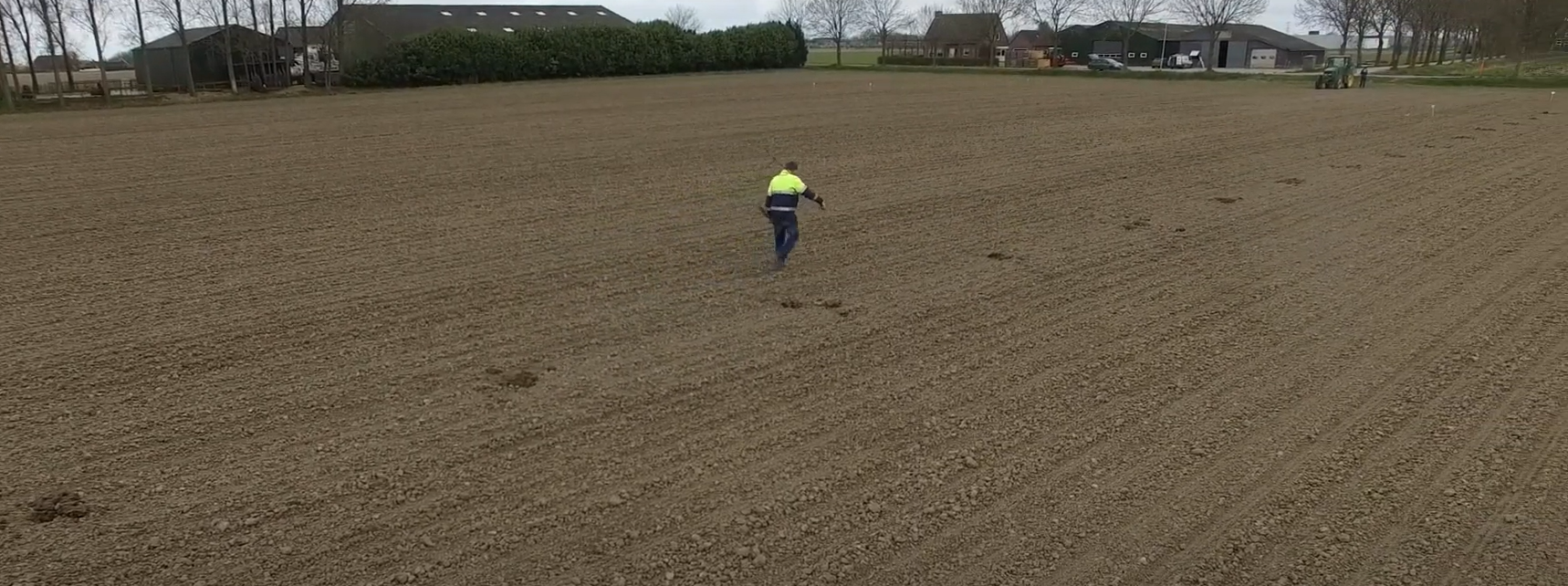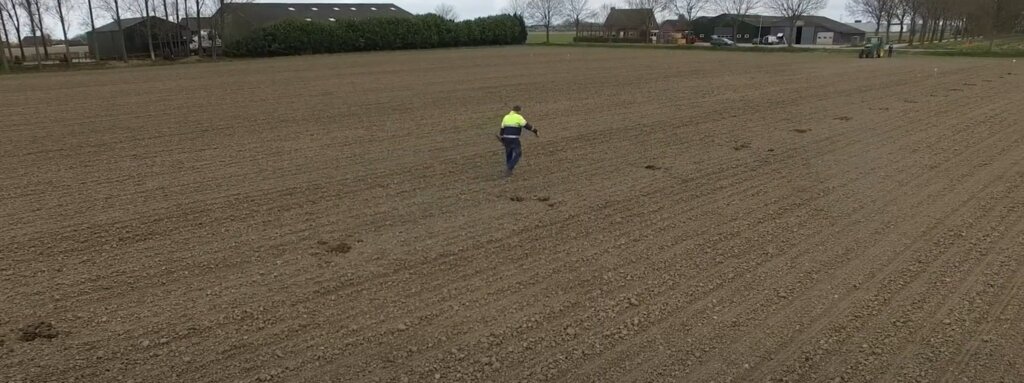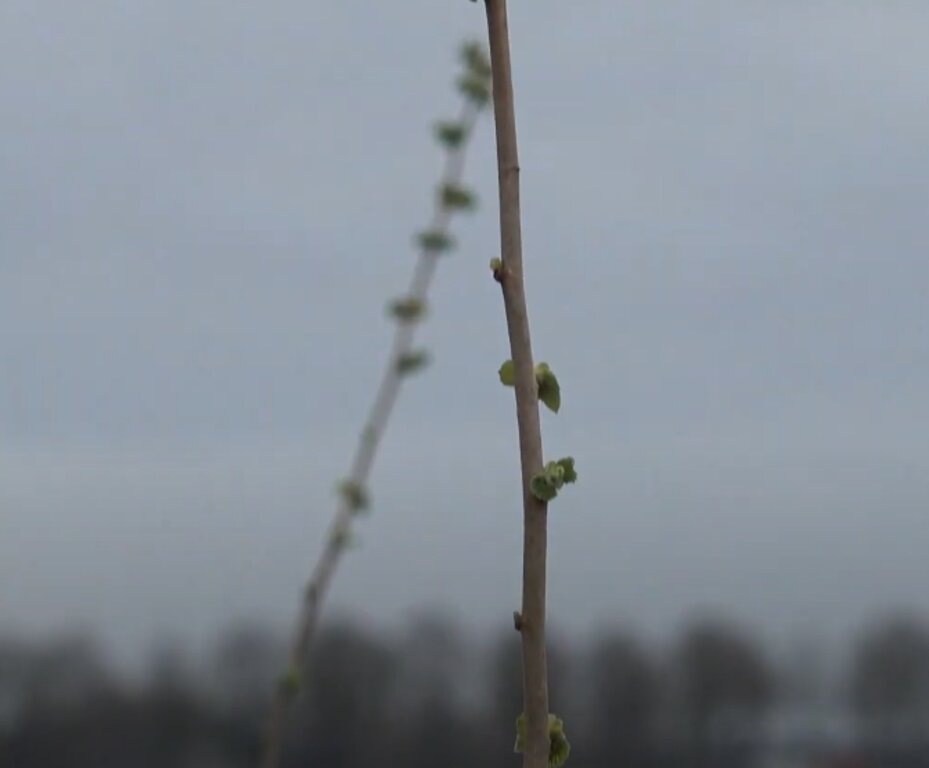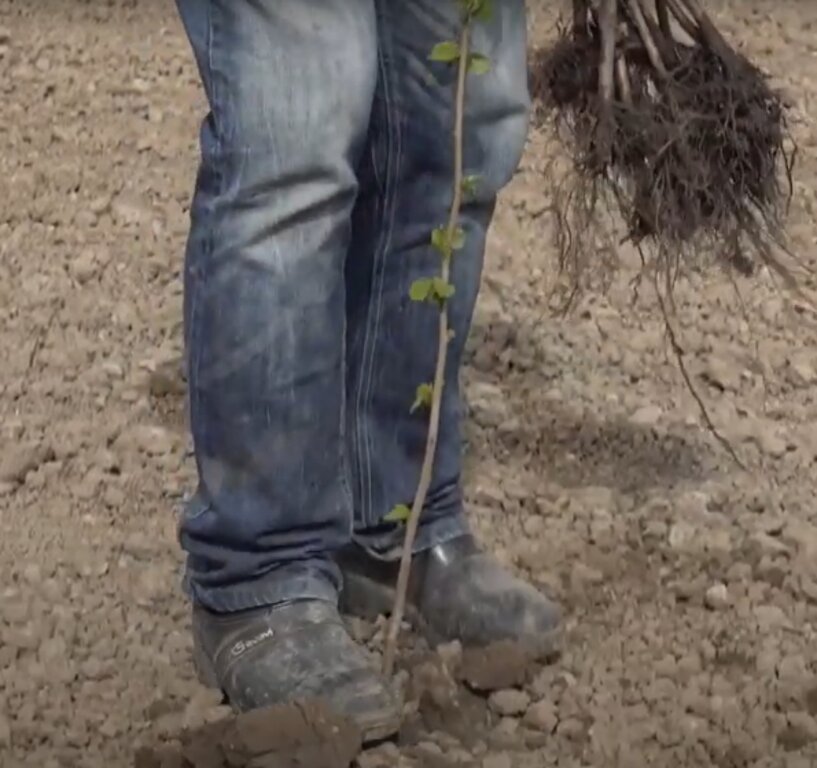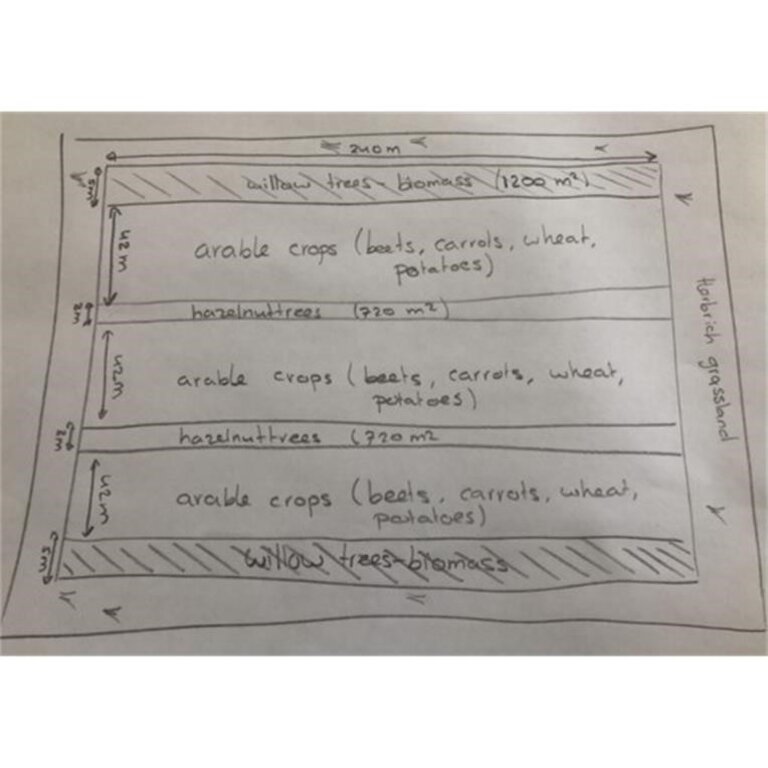Agroforestry on arable land [荷兰]
- 创建:
- 更新:
- 编制者: Alan Radbourne
- 编辑者: –
- 审查者: William Critchley, Rima Mekdaschi Studer
Agroforestry in Zevenbergen
technologies_6879 - 荷兰
查看章节
全部展开 全部收起1. 一般信息
1.2 参与该技术评估和文件编制的资源人员和机构的联系方式
关键资源人
SLM专业人员:
Hoogendijk Tijmen
Southern Agriculture and Horticulture Organization (ZLTO)
荷兰
土地使用者:
Hermus Piet
Akkerbouwbedrijf Hermus
荷兰
有助于对技术进行记录/评估的项目名称(如相关)
European Interreg project FABulous Farmers1.3 关于使用通过WOCAT记录的数据的条件
编制者和关键资源人员接受有关使用通过WOCAT记录数据的条件。:
是
1.4 所述技术的可持续性声明
这里所描述的技术在土地退化方面是否存在问题,导致无法被认为是一种可持续的土地管理技术?:
否
2. SLM技术的说明
2.1 技术简介
技术定义:
Willow and hazelnut trees have been planted in strips on arable land to reduce windspeed, decrease the leaching of nutrients and attract and support natural enemies of crops pests.
2.2 技术的详细说明
说明:
This agroforestry technology is being implemented on an arable field of 5.48 hectares in the South-West of the Netherlands. Strips of willow and hazelnut trees have been planted and arable crops are grown in between these strips. The outside of the field is banded with herb-rich grassland to attract natural enemies of the crop pests. In total there are four trees strips (two each of willow and hazelnut), each strip of 5 metres x 240 metres and separated by 42 metres. The land between tree strips is used for annual cropping. The willow trees were planted to produce biomass for bedding in a goat pen, and the hazelnuts were planted for the production of hazelnuts. The willows, especially, will attract many natural enemies to control insect pests of the crops. All trees were bought from a local grower. A planting machine was used to plant the cuttings (3600 pieces) of willow. The hazelnut seedlings (192 pieces) were planted by hand. Weed control between the rows of hazelnut trees will be done by a motorised two-wheel cultivator. Furthermore, a picking machine in front of a small tractor will be used to collect the hazelnuts. The farmer hopes that the trees will develop steadily and the first products can be harvested within three years.
2.3 技术照片
2.4 技术视频
注释、简短说明:
https://www.youtube.com/watch?v=snibuN3NitA
Explanation from Piet Hermus why he has chosen to grow trees on his arable land
日期:
01/02/2021
位置:
Zevenbergsche Hoek, Netherlands
摄影师的名字:
Future Farmers Film Productions
2.5 已应用该技术的、本评估所涵盖的国家/地区/地点
国家:
荷兰
区域/州/省:
Noord-Brabant
有关地点的进一步说明:
Zevenbergsche Hoek
具体说明该技术的分布:
- 均匀地分布在一个区域
如果不知道精确的区域,请注明大致覆盖的区域:
- < 0.1 平方千米(10 公顷)
技术现场是否位于永久保护区?:
否
Map
×2.6 实施日期
注明实施年份:
2021
2.7 技术介绍
详细说明该技术是如何引入的:
- 通过土地使用者的创新
- 通过项目/外部干预
注释(项目类型等):
Farmer's ideas supported as part of the FAB Farmers project
3. SLM技术的分类
3.1 该技术的主要目的
- 改良生产
- 减少、预防、恢复土地退化
- 保持/提高生物多样性
3.2 应用该技术的当前土地利用类型
同一土地单元内混合使用的土地::
是
具体说明混合土地使用(作物/放牧/树木):
- 农林业

农田
- 一年一作
- 乔木与灌木的种植
年作 - 具体指明作物:
- 谷类 - 小麦(春季)
- 根/块茎作物 - 土豆
- 蔬菜 - 根茎类蔬菜(胡萝卜、洋葱、甜菜等)
乔木和灌木种植 - 指定作物:
- 树坚果(巴西坚果、开心果、核桃、杏仁等)
每年的生长季节数:
- 1
采用间作制度了吗?:
否
采用轮作制度了吗?:
是
如果是,请具体说明:
4 year rotation of beet, carrots, wheat, potatoes.
3.3 由于技术的实施,土地使用是否发生了变化?
由于技术的实施,土地使用是否发生了变化?:
- 是(请在技术实施前填写以下有关土地利用的问题)
同一土地单元内混合使用的土地::
否

农田
- 一年一作
采用轮作制度了吗?:
是
3.4 供水
该技术所应用土地的供水:
- 混合雨水灌溉
3.5 该技术所属的SLM组
- 农业林学
- 防风林/防护林带
- 病虫害综合管理(包括有机农业)
3.6 包含该技术的可持续土地管理措施

植物措施
- V1:乔木和灌木覆盖层
3.7 该技术强调的主要土地退化类型

土壤风蚀
- Et:表土流失
3.8 防止、减少或恢复土地退化
具体数量名该技术与土地退化有关的目标:
- 防止土地退化
4. 技术规范、实施活动、投入和成本
4.1 该技术的技术图纸
技术规范(与技术图纸相关):
2 Strips of willow trees.: planting distance 1,5 by 1,5 meters. Cutting cycle 3 years. 3600 cuttings were planted
2 strips of hazelnut trees: Planting distance 5 by 2,5 meters. 195 hazelnut trees were planted.
Distance between tree rows: 42 meters
作者:
Tijmen Hoogendijk
日期:
23/01/2021
4.2 有关投入和成本计算的一般信息
具体说明成本和投入是如何计算的:
- 每个技术单元
指定单位:
per 5.48ha field
其它/国家货币(具体说明):
Euro
如相关,注明美元与当地货币的汇率(例如1美元=79.9巴西雷亚尔):1美元=:
0.92
4.3 技术建立活动
| 活动 | 时间(季度) | |
|---|---|---|
| 1. | Planting the trees | Winter |
| 2. | Cutting williow for planting | Winter |
4.4 技术建立所需要的费用和投入
| 对投入进行具体说明 | 单位 | 数量 | 单位成本 | 每项投入的总成本 | 土地使用者承担的成本% | |
|---|---|---|---|---|---|---|
| 劳动力 | Planting trees by hand by farmer | hours | 16.0 | 50.0 | 800.0 | 100.0 |
| 设备 | Planting machine willow cuttings | each | 1.0 | 300.0 | 300.0 | 100.0 |
| 植物材料 | Willow cuttings | Cuttings / trees | 3600.0 | 0.2 | 720.0 | 100.0 |
| 植物材料 | Hazelnut trees | trees | 200.0 | 2.5 | 500.0 | 100.0 |
| 技术建立所需总成本 | 2320.0 | |||||
| 技术建立总成本,美元 | 2521.74 | |||||
注释:
Total costs for establishment on 5.48ha field
4.5 维护/经常性活动
| 活动 | 时间/频率 | |
|---|---|---|
| 1. | Pruning trees | Anually |
| 2. | Irrigating young trees (as req) | summer |
| 3. | Harvesting nuts | Autumn |
| 4. | Weed control | as required |
4.6 维护/经常性活动所需要的费用和投入(每年)
| 对投入进行具体说明 | 单位 | 数量 | 单位成本 | 每项投入的总成本 | 土地使用者承担的成本% | |
|---|---|---|---|---|---|---|
| 劳动力 | Farmer time for pruning & harvesting | day | 3.0 | 250.0 | 750.0 | 100.0 |
| 劳动力 | Farmer time for weed control / irrigation (time varies) | day | 4.0 | 250.0 | 1000.0 | 100.0 |
| 设备 | Harvesting machine (price currently unknown) | hire / purchase | 1.0 | 100.0 | ||
| 技术维护所需总成本 | 1750.0 | |||||
| 技术维护总成本,美元 | 1902.17 | |||||
注释:
Harvesting machine costs currently unknown. Total costs for maintenance of 5.48 ha field.
4.7 影响成本的最重要因素
描述影响成本的最决定性因素:
Climate impacting requirement of irrigation time will vary. Main future cost is harvesting and the net costs with nut crop yield.
5. 自然和人文环境
5.1 气候
年降雨量
- < 250毫米
- 251-500毫米
- 501-750毫米
- 751-1,000毫米
- 1,001-1,500毫米
- 1,501-2,000毫米
- 2,001-3,000毫米
- 3,001-4,000毫米
- > 4,000毫米
农业气候带
- 半湿润
5.2 地形
平均坡度:
- 水平(0-2%)
- 缓降(3-5%)
- 平缓(6-10%)
- 滚坡(11-15%)
- 崎岖(16-30%)
- 陡峭(31-60%)
- 非常陡峭(>60%)
地形:
- 高原/平原
- 山脊
- 山坡
- 山地斜坡
- 麓坡
- 谷底
垂直分布带:
- 0-100 m a.s.l.
- 101-500 m a.s.l.
- 501-1,000 m a.s.l.
- 1,001-1,500 m a.s.l.
- 1,501-2,000 m a.s.l.
- 2,001-2,500 m a.s.l.
- 2,501-3,000 m a.s.l.
- 3,001-4,000 m a.s.l.
- > 4,000 m a.s.l.
说明该技术是否专门应用于:
- 不相关
5.3 土壤
平均土层深度:
- 非常浅(0-20厘米)
- 浅(21-50厘米)
- 中等深度(51-80厘米)
- 深(81-120厘米)
- 非常深(> 120厘米)
土壤质地(表土):
- 中粒(壤土、粉土)
土壤质地(地表以下> 20厘米):
- 中粒(壤土、粉土)
表土有机质:
- 中(1-3%)
5.4 水资源可用性和质量
地下水位表:
< 5米
地表水的可用性:
好
水质(未处理):
不良饮用水(需要处理)
水质请参考::
地下水和地表水
水的盐度有问题吗?:
否
该区域正在发生洪水吗?:
否
5.5 生物多样性
物种多样性:
- 中等
栖息地多样性:
- 中等
关于生物多样性的注释和进一步规范:
Agrobiodiversity will increase with the new system
5.6 应用该技术的土地使用者的特征
定栖或游牧:
- 定栖的
生产系统的市场定位:
- 商业/市场
非农收入:
- 低于全部收入的10%
相对财富水平:
- 平均水平
个人或集体:
- 个人/家庭
机械化水平:
- 机械化/电动
性别:
- 男人
土地使用者的年龄:
- 中年人
5.7 应用该技术的土地使用者使用的平均土地面积
- < 0.5 公顷
- 0.5-1 公顷
- 1-2 公顷
- 2-5公顷
- 5-15公顷
- 15-50公顷
- 50-100公顷
- 100-500公顷
- 500-1,000公顷
- 1,000-10,000公顷
- > 10,000公顷
这被认为是小规模、中规模还是大规模的(参照当地实际情况)?:
- 中等规模的
5.8 土地所有权、土地使用权和水使用权
土地所有权:
- 公司
土地使用权:
- 个人
用水权:
- 社区(有组织)
土地使用权是否基于传统的法律制度?:
否
5.9 进入服务和基础设施的通道
健康:
- 贫瘠
- 适度的
- 好
教育:
- 贫瘠
- 适度的
- 好
技术援助:
- 贫瘠
- 适度的
- 好
就业(例如非农):
- 贫瘠
- 适度的
- 好
市场:
- 贫瘠
- 适度的
- 好
能源:
- 贫瘠
- 适度的
- 好
道路和交通:
- 贫瘠
- 适度的
- 好
饮用水和卫生设施:
- 贫瘠
- 适度的
- 好
金融服务:
- 贫瘠
- 适度的
- 好
6. 影响和结论性说明
6.1 该技术的现场影响
社会经济效应
生产
作物生产
注释/具体说明:
loss of land off-set by future nut production
木材生产
注释/具体说明:
Introduction of woody features
生产区域
注释/具体说明:
Land given over to windbreak / other production of wood & nuts
土地管理
注释/具体说明:
More variety of skills, equipment and more time required.
收入和成本
农业投入费用
注释/具体说明:
Costs of installation
农业收入
注释/具体说明:
Short-term costs as nut and wood production not quick return
收入来源的多样性
注释/具体说明:
Eventually a diversity of products will support long term sustainability
工作量
注释/具体说明:
Time costly for installation and ongoing maintenence & harvesting.
生态影响
土壤
土壤水分
土壤覆盖层
土壤流失
注释/具体说明:
Buffer strip action
生物多样性:植被、动物
植被覆盖
生物量/地上C
注释/具体说明:
greater above ground with woody features
植物多样性
有益物种
减少气候和灾害风险
干旱影响
风速
对现场影响的评估(测量)进行具体说明:
Based on expert opinion.
6.2 该技术的场外影响已经显现
对场外影响(测量)的评估进行具体说明:
Not large enough to have a significant impact downstream.
6.3 技术对渐变气候以及与气候相关的极端情况/灾害的暴露和敏感性(土地使用者认为的极端情况/灾害)
渐变气候
渐变气候
| 季节 | 增加或减少 | 该技术是如何应对的? | |
|---|---|---|---|
| 年温度 | 增加 | 适度 |
6.4 成本效益分析
技术收益与技术建立成本相比如何(从土地使用者的角度看)?
短期回报:
消极
长期回报:
稍微积极
技术收益与技术维护成本/经常性成本相比如何(从土地使用者的角度看)?
短期回报:
轻度消极
长期回报:
轻度消极
6.5 技术采用
- 单例/实验
6.6 适应
最近是否对该技术进行了修改以适应不断变化的条件?:
否
6.7 该技术的优点/长处/机会
| 土地使用者眼中的长处/优势/机会 |
|---|
| Adds a future variety of produce |
| Wind break will aid crop protection |
| 编制者或其他关键资源人员认为的长处/优势/机会 |
|---|
| Increases beneficial species |
| Improves soil health |
| Better long-term business prospects for sustainability |
6.8 技术的弱点/缺点/风险及其克服方法
| 土地使用者认为的弱点/缺点/风险 | 如何克服它们? |
|---|---|
| Short-term financial and time cost | Grant funding |
| No guarentee of good nut or wood yield | Ensure maintenence to highest standard to improve chance of good yield. |
| 编制者或其他关键资源人员认为的弱点/缺点/风险 | 如何克服它们? |
|---|---|
| Knowledge of markets for new products need to be identified early | Gain advice from SLM expert |
7. 参考和链接
7.1 信息的方法/来源
- 实地考察、实地调查
1
- 与土地使用者的访谈
1
(现场)数据是什么时候汇编的?:
01/03/2022
链接和模块
全部展开 全部收起链接
无链接
模块
无模块


